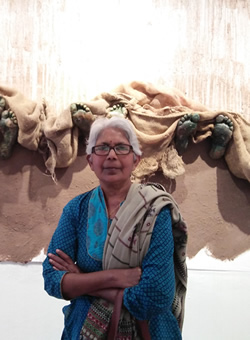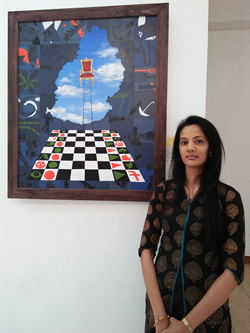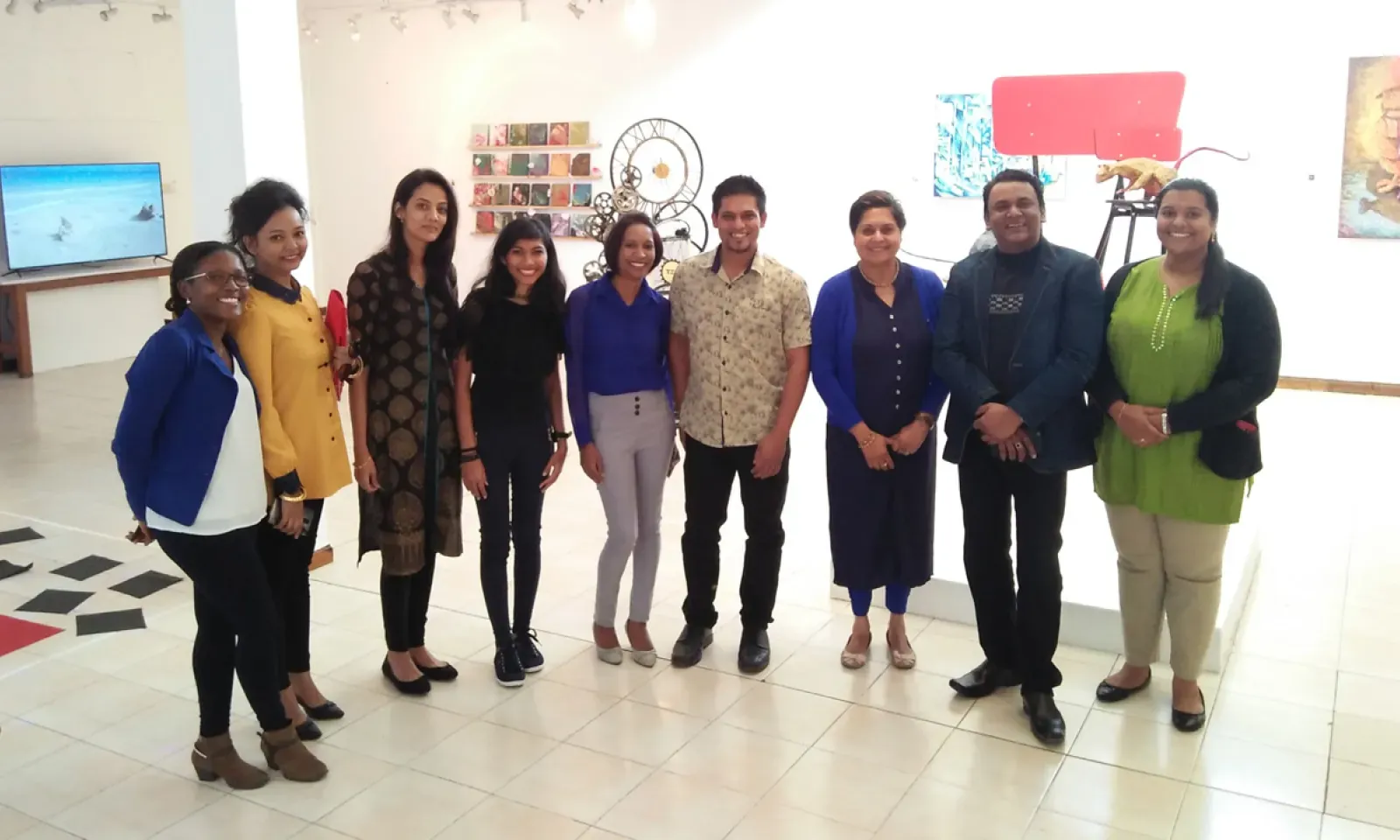
The best way to predict the future is to create it and this is what our young Mauritian artists are doing. In spite of not having a single permanent art gallery in the country, we are organising art exhibitions on a regular basis, where artists and tourists can have a look at Mauritian art. But, the good news is that a scarcity of resources cannot hinder your path to success.
We have young artists who have unlimited imagination as well as brushes in their hands. They are writing the future of art through different mediums and in their own, different styles. A few decades ago, art was an exclusive place only for the elite. This prerogative still exists today, to a certain point. However, the future if art will be threatened if we don’t render it ‘Inclusive’ in Mauritius. Our geographical limitations may hinder us, but we have the responsibility to make this art inclusive, if we want our art and artists to survive. This article is one such attempt to teach the regular people about the importance of art in life and will briefly introduce the concept of how an artist creates a piece of art.

Kaushnee Jhurree:
“At primary level, the theoretical part of art should be included”
For the first time in my life, I met a painter who burned her painting. Yes, she literally burned a part of canvas to bring the real effects. She painted the riots that took place after the Faya incident in Mauritius. This work of art reflects how she remembers what happened at that time in our history. Kaushnee says: “It is hard for any artist to burn a painting but I wanted to show that nothing is eternal.” As for the future of art in Mauritius, Kaushnee thinks that it is quite promising. There are many art exhibitions coming up on regular basis nowadays in Mauritius. As an educator, she believes that at primary level, the theoretical part of art should be included a little so that the kids could understand what exactly art is. This will eventually create a society that understands art. It will be good for the future of art on the island.
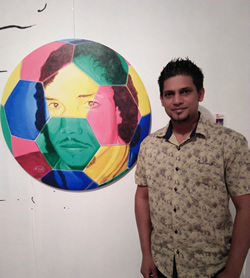
Nishal Purbhoo:
“We need a permanent art gallery”
The canvas of art includes everything, even football. That’s what I felt when I saw Nishal’s painting. He paid tribute to Dany Imbert, the famous football player of Mauritius of the 1970’s and 1980’s, who made football famous here. Interestingly, this painting is done on a round canvas reflecting the shape of a football. Nishal has completed 18 years in art business. He is also an educator and he has participated in around 50 exhibitions.
However, the exhibition he organized in Rodrigues, in association with the local artists, is the one closest to his heart. He says artists in Rodrigues are very talented; they just need proper guidance and promotion. Talking about Mauritius, he declares: “We need a permanent art gallery. I have been to many countries and saw that they invest a lot in art and galleries. Here in Mauritius, art means more like a kind of music. All kinds of art should be promoted.”

Neermala Luckeenarain:
“The media has the power to promote the importance of art”
There are many forms of art; one of them is print making and installation. Neermala Luckeenarain has been in this industry for nearly four decades now.
She says new comers can choose whatever style suits them, but they should not rush into installation. “You should first start with paint, you should draw, you should sculpt, print, and try to understand the concept of art before coming into installation, because you need a strong concept for this. As for the future, the Ministry of Art and Culture is giving grants to artists. The public should be sensitized towards art. The media has the power to promote the importance of art. They should explain it to the people that art is food for thought.”
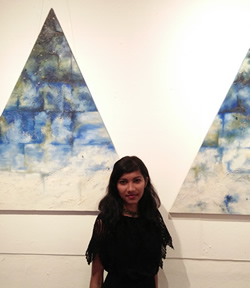
Anousha Bissessur:
“It is a bit tough in Mauritius to be a full time artist”
This young woman has a triangular shape canvas and it came out that she has made all her canvases herself, according to her necessity. Through her painting, she represents the development of Mauritius in the shape of hierarchy with the theme “root to peak.”
A graduate in Fine Arts, Anousha declares: “It is a bit tough in Mauritius to be a full time artist,” she states. She has to find a proper job first if she wants to survive as an artist for a long time. “The paintings are not sold often in exhibitions, so we keep all of our paintings and when there is a sufficient amount of items, I can go for a solo exhibition.” According to Anousha, what we need today in the Mauritian society are buyers for our paintings, especially buyers who understand that art is priceless.
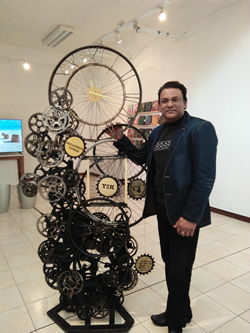
Vick Kumar Shibdoyal:
“In Mauritius people don’t understand the value of art”
This artist has a very interesting story of his progress as an artist. Vick affirms: “When I was studying art, I didn’t have much money to spend on expensive materials; so I thought about how to make artwork by using inexpensive material. I started collecting castaways and scrap materials.
I assembled those using my imagination and creativity to make an artwork. I feel every thrown away thing have something to say, they can communicate if given a chance. Now as an artist, I am promoting all kinds of “sustainably art practices.” I try to use all kinds of scrap materials, plastic, papers, metals, and so on, and try to turn them into an art pieces. Through my art practices, I am promoting environment sustainability.
For me, art is to make meaning out of nothing.” As for the state of art marketing in Mauritius, Vick says: “Of course, it is hard to sell here. First, we have to educate people how to appreciate art. In Mauritius people don’t understand the value of art. We have to explain the concept of artwork, how it contains a meaning and a message, which have to be decoded. Then maybe in future, people will come out and start to buy artworks,” concludes Vick.
Mala Chummun:
“There should be one place where all artists can conduct workshops”
Along with young artists, I also met a few from the earlier generation to know how this art industry has evolved on the island. I met an artist who showcases social changes through art. She has been in the field of art for the past 40 years. Mala thinks that if “we tell the newer generation how the older generation has built this country brick by brick, then they will value our culture more.
If our history is shown through the in form of art, it will have a more powerful impact.” She remembers the days when there was an economic boom in the sugarcane industry. Yet, these labourers who were toiling and contributing to the economy were living in pitiable conditions. She has used cow dung and gunny bags to showcase her art. According to Mala, the art industry has changed positively in Mauritius.
She remembers when they started the “Salon de Mai” three to four decades ago; there were 18 artists and this year they have showcased 50 artists. She thinks that if the art is rich, then the country is rich. When asked about the necessity of art in Mauritius today, Mala says: “It is definitely the art gallery. There should be at least one place where all artists can meet and conduct workshops.”

Samanta Shiwpursad:
“The future looks promising, as people are exploring new ideas”
Samanta created art by using bicycle spare parts to make a very beautiful artwork. Seven years into the art industry is quite satisfying for her. As an educator, she does art for exhibition and personal satisfaction.
She says, “We don’t have a market for artists, so you can’t depend solely on art for a living, but the artist has to work hard and after some time, can earn a decent living through art. The future looks promising, as people are exploring new ideas and doing innovations.”
Divya Ramrecha:
“The Government has implemented new schemes to help artists”
Divya used the power of social media through her painting. According to her, social media became a determining factor in the 2014 general elections of Mauritius. Divya had combined politics with the game of chess and social media along with Mauritius in one painting.
She has just returned from India after pursuing six years of education in art. She says that the art culture is very different in India; it is a big country, so it was a great learning and enriching experience. As for Mauritius, many artists are coming up with new forms which are really inspiring. The current Government has also implemented new schemes to help aspiring artists.
Divya feels that in Mauritius, people need to be more informed what positivity art can bring into society. It is very necessary if we want art to flourish on the island.
Bio
Savita Tiwari is a freelance journalist exploring Mauritius in all possible ways. She loves to write on every subject under the sun. Education and Children are her favourite topics.
You can contact her on facebook/savitapost.
Mail: [email protected]








